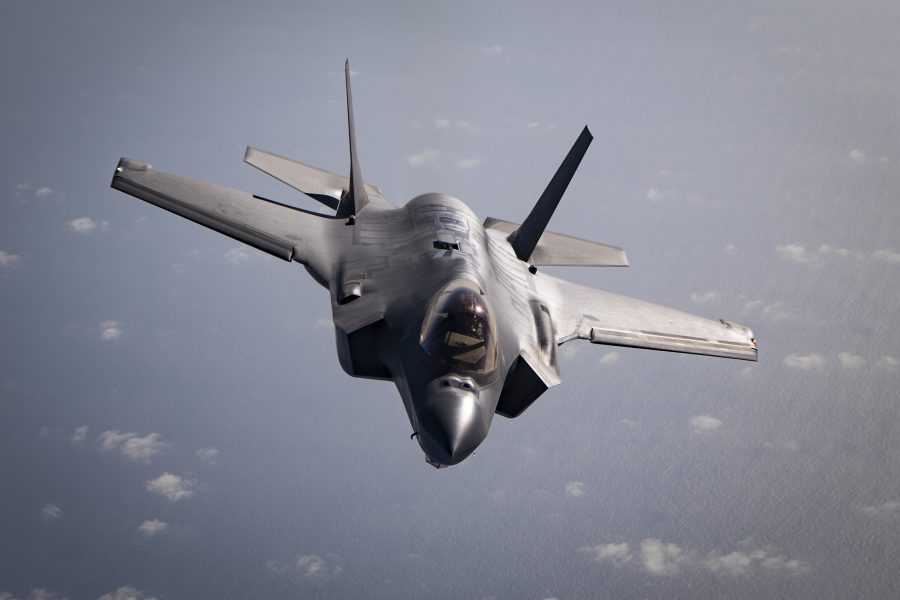Lockheed Martin and the U.S. government are working out a down-scoped version of the F-35 Performance-Based Logistics concept the company pitched 18 months ago, but the goal is still to get the fighter’s operating cost to $25,000 a year by 2025, in fiscal year 2012 dollars.
“We skinnied … down” the scope of the PBL concept, Ken Merchant, Lockheed F-35 sustainability vice president, told reporters in an online press conference to coincide with AFA’s virtual Aerospace Warfare Symposium. The government is expected to release a sole-source request for proposals to Lockheed in the coming months, but Merchant couldn’t predict when the company could get a contract.
“The sooner we get the PBL enacted, the sooner we’ll see the improvements and savings,” Merchant said. Under a PBL contract, the company guarantees a certain number of aircraft will be mission capable a certain percentage of the time, and can achieve that goal however it sees fit. Bruce Litchfield, Lockheed aeronautics VP for sustainment, said subcontractors on the PBL plan “have the option to do reliability improvements, repair capacity increases, and partnerships with the depots.”
With the down-scoped PBL, overall savings will be lower, Merchant said. He couldn’t speculate as to what the savings will be until the company sees the final RFP, but they won’t be “anywhere near what we had hoped for before.” However, sustainment performance will be at least as good, he said.
The government balked at handing so much authority over to Lockheed to make long-term decisions about how parts and sustainment would be managed, Merchant said. Although other governments—F-35 partners—are comfortable with such deals, such arrangements are relatively rare in the U.S., he said. BAE Systems, for example, manages the Typhoon fighter’s sustainment, and in Australia, contractors get “stewardship” contracts, Merchant noted.
What the two parties ended up with is a “try before buy” arrangement of five years, Merchant said. “If it’s successful, there’s an opportunity to do another five and another five after that. If it’s not, there’s planned to be off-ramps that will allow the government to go other routes,” he explained.
The company has confidence it can deliver on the down-scoped PBL because it has already reduced costs per flying hour by 40 percent, on the items “that Lockheed controls,” Merchant noted. The government controls 49 percent of the cost per flying hour on the F-35, he said, and he quoted the current cost per flying hour as $36,000.
Lockheed has done some PBLs with its own contractors, but can’t go too far in doing so, Merchant said. “I can’t really go out and make commitments for my company that are going to take five years to [see] a return on investment,” he said. “With a PBL, I can make those investments up front and I’m assured … that I’ll get a fair return on those dollars over time.”
“What we’re pressing forward with now is a supply, support, and demand reduction capability,” Merchant said. The company will be focused on spares, ensuring parts bins are full and “the right supplies are in the field where needed.” The company will also be “looking for ways to reduce that demand for spare parts by improving repair capacity across the enterprise” of F-35 users, “as well as keeping parts on-wing longer.”
Merchant said that 92 percent of the parts flying on the F-35 today “are performing at or better than specification.” The other eight percent are being scrutinized for how they can be more reliable, available, and maintainable. Among the approaches is to accelerate the cure time on low observable parts, to turn them faster and get the aircraft back into service.
Lockheed has set up some PBLs with its own suppliers. “Even though we’re on annual contracts” with the government, the company has signed some five-year deals with suppliers and “taken risk” in doing so. BAE was put in charge of electronic warfare sustainment and the move “has brought the right behavior to that supplier in that enterprise.”
Parts are more plentiful, he said, once at 47 percent “fill rate” and now at 97 percent, “and that just over two years out of a five-year plan.” The organic repair capacity for EW systems was also stood up “several months ahead of plan.”
All of this “gives us great confidence” that the PBL can eventually be expanded “to the program level,” Merchant said.
That said, “there’s still a lot of things we need to go fix, and we need more velocity in the repair system,” he said.
Litchfield emphasized that costs per flying hour on the F-35 are coming down, and said the company can “unleash a lot of the capabilities we have, to drive efficiency” on sustainment.
In the field, Merchant said, “maintainers say the jet is King Kong. It’s really starting to improve and … mature.” There was a 13 percent increase in mission capability rates in 2019, and today the fleet average, globally, is 70 percent, he asserted. That didn’t happen because of the increase in the number of aircraft serving—now up to 615 aircraft—but “because we designed in reliability and have worked to improve the performance of those jets.” Lockheed expects to deliver between 133 and 139 F-35s in 2021, he added.
